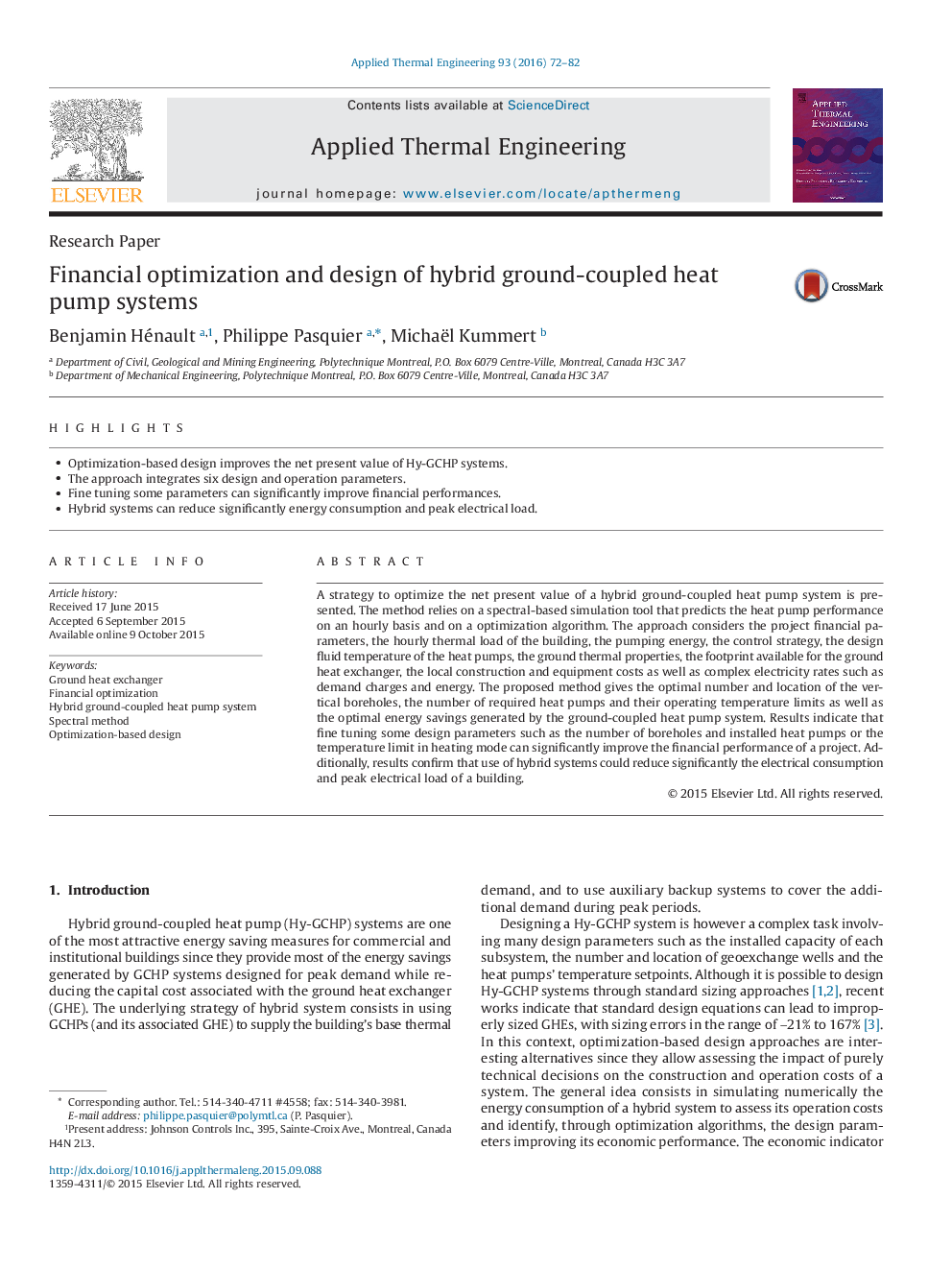| کد مقاله | کد نشریه | سال انتشار | مقاله انگلیسی | نسخه تمام متن |
|---|---|---|---|---|
| 7048714 | 1457135 | 2016 | 11 صفحه PDF | دانلود رایگان |
عنوان انگلیسی مقاله ISI
Financial optimization and design of hybrid ground-coupled heat pump systems
ترجمه فارسی عنوان
بهینه سازی مالی و طراحی سیستم های پمپ حرارتی ترکیبی زمین
دانلود مقاله + سفارش ترجمه
دانلود مقاله ISI انگلیسی
رایگان برای ایرانیان
کلمات کلیدی
مبدل حرارتی زمینی، بهینه سازی مالی، سیستم پمپ گرما ترکیبی متصل به زمین، روش طیفی، طراحی مبتنی بر بهینه سازی
ترجمه چکیده
یک استراتژی برای بهینه سازی ارزش فعلی خالص یک سیستم پمپ گرمادهی ترکیبی زمین همراه است. روش متکی بر ابزار شبیه سازی مبتنی بر طیفی است که عملکرد پمپ گرما را به صورت ساعت و الگوریتم بهینه سازی پیش بینی می کند. این رویکرد، پارامترهای مالی پروژه، بار حرارتی ساعتی ساختمان، انرژی پمپاژ، استراتژی کنترل، دمای مایع طراحی پمپ های حرارتی، خواص حرارتی زمین، پدیده موجود برای مبدل حرارتی زمین، ساخت و ساز محلی و هزینه های تجهیزات و همچنین هزینه های پیچیده برق مانند هزینه های تقاضا و انرژی. روش پیشنهادی تعداد و محل حفاری عمودی، تعداد پمپ های گرمایش مورد نیاز و محدودیت های دمای کار آنها و همچنین صرفه جویی در انرژی بهینه انرژی تولید شده توسط سیستم پمپ گرمای زمین همراه می شود. نتایج نشان می دهد که تعدیل پارامترهای طراحی مانند تعداد گمانه ها و پمپ های گرمایش نصب شده یا محدودیت دما در حالت گرمایشی می تواند عملکرد مالی یک پروژه را به طور قابل توجهی بهبود بخشد. علاوه بر این، نتایج تایید می کند که استفاده از سیستم های هیبریدی می تواند به طور قابل توجهی کاهش مصرف برق و حداکثر بار الکتریکی ساختمان.
موضوعات مرتبط
مهندسی و علوم پایه
مهندسی شیمی
جریان سیال و فرایندهای انتقال
چکیده انگلیسی
A strategy to optimize the net present value of a hybrid ground-coupled heat pump system is presented. The method relies on a spectral-based simulation tool that predicts the heat pump performance on an hourly basis and on a optimization algorithm. The approach considers the project financial parameters, the hourly thermal load of the building, the pumping energy, the control strategy, the design fluid temperature of the heat pumps, the ground thermal properties, the footprint available for the ground heat exchanger, the local construction and equipment costs as well as complex electricity rates such as demand charges and energy. The proposed method gives the optimal number and location of the vertical boreholes, the number of required heat pumps and their operating temperature limits as well as the optimal energy savings generated by the ground-coupled heat pump system. Results indicate that fine tuning some design parameters such as the number of boreholes and installed heat pumps or the temperature limit in heating mode can significantly improve the financial performance of a project. Additionally, results confirm that use of hybrid systems could reduce significantly the electrical consumption and peak electrical load of a building.
ناشر
Database: Elsevier - ScienceDirect (ساینس دایرکت)
Journal: Applied Thermal Engineering - Volume 93, 25 January 2016, Pages 72-82
Journal: Applied Thermal Engineering - Volume 93, 25 January 2016, Pages 72-82
نویسندگان
Benjamin Hénault, Philippe Pasquier, Michaël Kummert,
